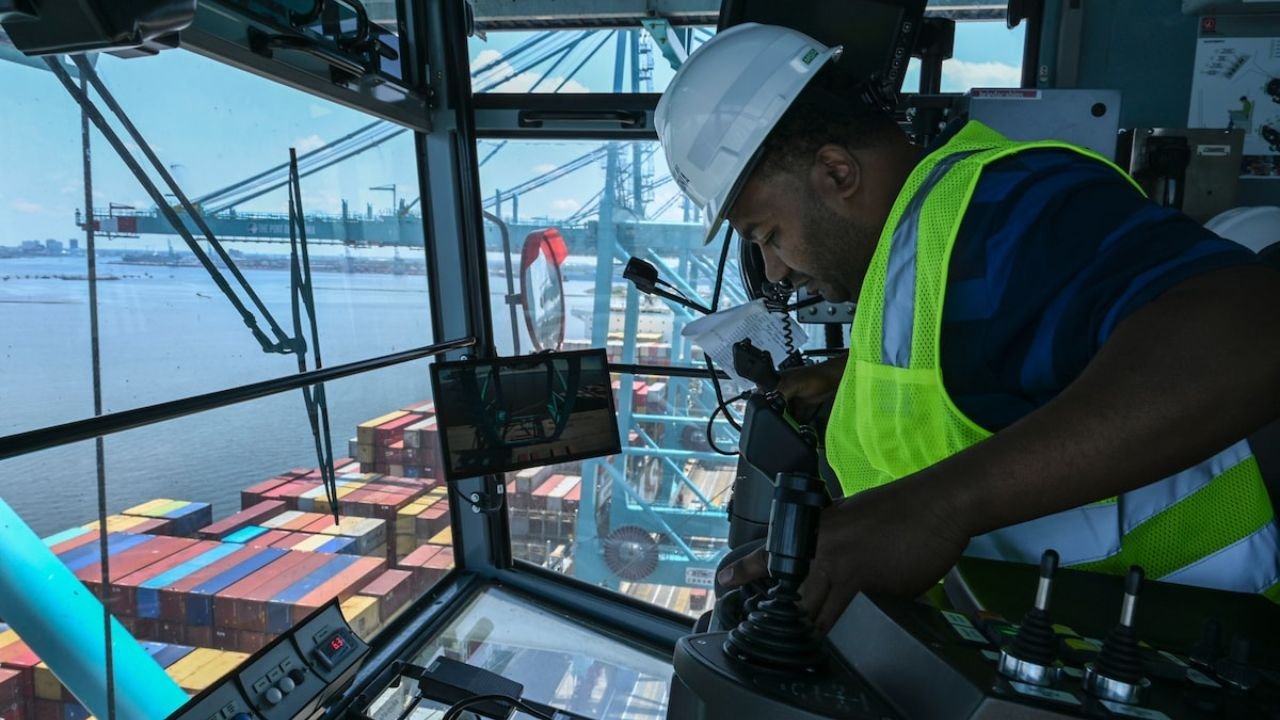Table of Contents
Learn about the 47,000 dockworker strike, fighting automation that threatens jobs. Discover how this will impact workers and the future of work. For the first time since 1977, 47,000 Dockworker Strike have gone on strike across all East Coast and Gulf Coast ports in the United States. Containers that carry everything from cars to bananas sit idle as these workers demand change. But this strike goes far beyond simple concerns over wages and working conditions. At its core, this labour action represents the beginning of a larger battle — the fight between workers and advanced automation. As technology evolves and threatens jobs, this strike could be the first of many.
Why Dockworker Strike in 2024
This strike has gained national attention, not just because of the potential impact on holiday shopping or grocery prices, but because it represents a broader conflict in the modern workforce. The primary reason? Automation — the introduction of machines that can perform tasks traditionally carried out by humans. While Dockworker Strike are demanding higher wages and improved benefits, the long-term concern is the risk of job displacement due to technology.
The Role of Automation in the Shipping Industry
Shipping ports are vital to global trade. However, technological advancements mean that fewer workers are needed to manage operations. Tasks such as operating cranes and moving containers — once done manually — can now be automated. Cranes controlled by computers unload ships, while machines transport containers to rail or road hubs.
Ports in Los Angeles, Long Beach, and Virginia have already introduced semi-automation. This process reduces the need for human workers and, naturally, leads to a potential reduction in wages, job security, and long-term employment prospects for Dockworker Strike.
The Threat of Job Losses Due to Automation
For American workers, automation isn’t a future threat — it’s already happening. A 2022 study from the Economic Roundtable found that automation in Californian ports led to the loss of 572 jobs annually, about 5% of the workforce. As automation spreads to other ports, many fear these numbers will only rise.
Thomas Little, a dockworker since 1969, recalls how his job provided a middle-class lifestyle for hundreds of families, particularly workers of colour. Now, he fears that automation will erase the livelihood that dock work has long provided. “No one really wants a strike,” Little says, “but we cannot stand by and allow machines to take our jobs.”
The International Longshoremen’s Association (ILA) and Their Demands
The International Longshoremen’s Association (ILA), which represents Dockworker Strike, is pushing for wage increases, improved benefits, and protections against job losses caused by automation. Their dispute is with the United States Maritime Alliance, representing shipping lines and port terminals.
Although some issues — such as wages and camera surveillance in the workplace — might be relatively easy to resolve, the more complex question remains: Will machines replace workers?
The Impact of Automation on Wages
In the past, Dockworker Strike were able to secure substantial wage increases during periods of labour unrest. For instance, the West Coast Dockworker Strike contract in 2022 resulted in significant pay hikes. Workers at the ports can earn up to $39 an hour, a rate that reflects the physically demanding nature of the job and the associated risks.
But with the rise of automation, there’s concern that wages will stagnate, or even decline, as fewer workers are needed to perform tasks that machines can handle. Although automation might improve efficiency, workers worry that it will lead to an erosion of well-paid, stable employment.
Automation’s Global Context
The automation of ports is not limited to the United States. In fact, only 63 ports worldwide had advanced automation in 2022, a fraction of the 1,300 container terminals across the globe. However, the shipping industry views automation as an inevitability, a future where machines dominate operations.
Examples of Automated Ports Around the World
Port operators often look to Rotterdam as an example of the benefits of automation. As one of the first major ports to automate, it is considered the global model for the use of technology in shipping. However, automation there came with generous early retirement packages for workers, which helped soften the blow of job losses. Similar compromises might be necessary as automation spreads to other parts of the world.
Financial Implications for Ports
Port operators argue that automation brings significant financial benefits, such as increased safety and standardised performance. However, Geraldine Knatz, former executive director of the Port of Los Angeles, has noted that many U.S. terminals failed to achieve the anticipated reduction in labour costs after introducing automation.
This suggests that while automation may streamline operations, it doesn’t always lead to the massive cost savings that employers expect. With the high upfront costs of automation — including purchasing equipment, much of which comes from China — port operators must carefully weigh the benefits and risks of implementing new technologies.
Read More: Vice Presidential Debate Tactics Decoded: What Vance and Walz Must Nail to Win Big
Security Concerns Over Foreign Automation Equipment
Automation comes with geopolitical concerns as well. Much of the equipment needed for automation is manufactured in China, a nation that the Biden administration has identified as a potential security threat. There are efforts underway to manufacture automation equipment domestically, but this adds another layer of complexity to the automation debate.
The Impact on Consumers
Consumers are naturally concerned about how this strike might affect their day-to-day lives. The longer the strike continues, the more likely it is that store shelves will become emptier, and prices will rise. With the holiday season approaching, many Americans are wondering if toys, electronics, and other goods will be available in time for Christmas.
While this short-term disruption is important, the long-term implications of the strike are even more significant. If automation continues to spread unchecked, it could lead to permanent changes in the structure of the American workforce, with many well-paid jobs disappearing.
Automation and Other Industries
Dockworker Strike are not the only group at risk of being displaced by automation. Workers in industries ranging from manufacturing to transportation are facing similar challenges. Self-driving trucks, for example, could soon reduce the need for human drivers, while robots are increasingly being used in factories to perform tasks once completed by workers.
The Future of American Workers
As automation advances, it raises questions about the future of work in America. While technology can make industries more efficient and safer, it also poses a significant risk to job security. The Dockworker Strike highlights the need for a balance between technological progress and the protection of workers’ livelihoods.
Possible Solutions: Automation and Workers’ Rights
There are potential solutions to this conflict. One option could be offering retraining programs for workers displaced by automation, enabling them to transition into new roles, such as overseeing or maintaining the machines themselves. Another solution might involve negotiating compensation packages, as was done in Rotterdam, to ensure that workers aren’t left behind as technology advances.
Read More: Netflix Spins Excitement with ‘Beyblade X’ Anime – Coming This October!
Conclusion: The First of Many Battles
The strike involving 47,000 Dockworker Strike isn’t just a dispute over wages or working conditions. It’s the start of a larger conflict between workers and automation, a battle that could reshape the future of employment in America. As machines take over more tasks, it’s crucial to consider how this will impact workers and how industries can strike a balance between efficiency and job security.
While this strike will affect what’s on store shelves in the short term, its broader impact will be felt for years to come. This is just the first of many battles American workers will face in the age of automation.
FAQs
1. What is the main reason for the Dockworker Strike?
The strike is primarily about concerns over advanced automation, which threatens to replace workers with machines. While wage increases and benefits are also part of the negotiations, job displacement due to automation is the key issue.
2. How does automation affect Dockworker Strike?
Automation reduces the need for human labour in tasks such as operating cranes and moving containers. As machines take over these roles, fewer workers are required, leading to job losses and concerns about the long-term viability of well-paid positions.
3. Has automation been introduced at other ports?
Yes, automation has been introduced at several ports around the world, including in Rotterdam and the U.S. cities of Los Angeles, Long Beach, and Virginia. However, automation remains relatively rare globally.
4. How might the strike affect consumers?
The strike could lead to shortages of goods, particularly around the holiday season, as containers sit idle at ports. Prices may also rise if the strike continues for an extended period.
5. Are there any potential solutions to the conflict between workers and automation?
Possible solutions include retraining programs for workers displaced by automation and negotiating compensation packages to help workers transition to new roles or retire early, as seen in Rotterdam.

